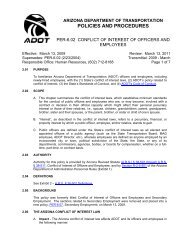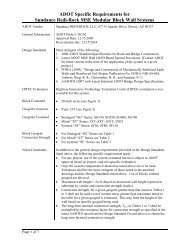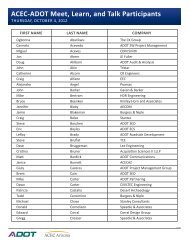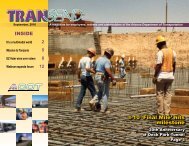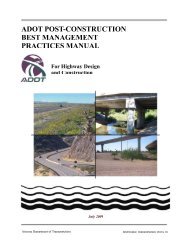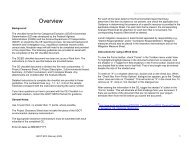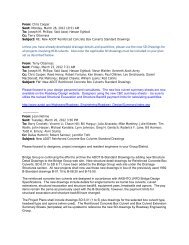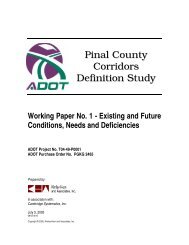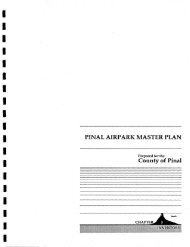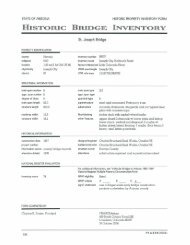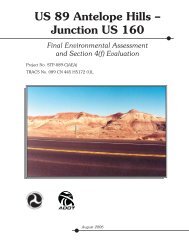I-10 Twin Peaks Traffic Interchange, Environmental Assessment
I-10 Twin Peaks Traffic Interchange, Environmental Assessment
I-10 Twin Peaks Traffic Interchange, Environmental Assessment
Create successful ePaper yourself
Turn your PDF publications into a flip-book with our unique Google optimized e-Paper software.
Mitigation Measures October 2005<br />
• Riparian trees greater than 4 inches diameter at breast height that are removed<br />
for construction would be replaced in kind at a 3:1 ratio with a minimum<br />
container size of 15 gallons.<br />
• When fully restored, the vegetation within the Santa Cruz River would<br />
provide continuous tree cover through the project limits.<br />
• The bottom of the bridges would be approximately 20 feet above the bottom<br />
of the low flow channel of the Santa Cruz River, which should provide<br />
sufficient height to allow pygmy-owls and other wildlife to move unimpeded<br />
under the bridges.<br />
• The Town of Marana would provide water for all plantings outside the low<br />
flow channel of the Santa Cruz River for a period of two years to facilitate<br />
their establishment.<br />
• The Town of Marana would monitor all plantings for a period of two years,<br />
starting at the time of planting, on a quarterly basis. Two yearly reports would<br />
be generated and submitted to the U.S. Fish and Wildlife Service and the<br />
Arizona Department of Transportation’s <strong>Environmental</strong> and Enhancement<br />
Group discussing the progress of the revegetation effort.<br />
• The revegetation plan would comply with the Arizona Native Plant Law, and<br />
Native Plant Protection Ordinances of the Town of Marana and Pima County.<br />
In addition, the revegetation plan would also include U.S. Army Corps of<br />
Engineers recommended mitigation measures for the Santa Cruz River<br />
Channel.<br />
• The revegetation plan would be developed based on the objectives of the Tres<br />
Rio del Norte Feasibility Study. Tres Rio del Norte planning objectives related<br />
to vegetation on the Santa Cruz River include: creating a mesquite bosque at<br />
higher elevations from the Santa Cruz River bottom on terraces and over-bank<br />
areas; plant and establish cottonwood and willow tree plant communities<br />
along the wetted perimeter, and fringe area locations within the Santa Cruz<br />
River; established wetlands/Cienega at appropriate locations, to create a<br />
diverse and high value project habitat; and, reestablish desertscrub plant<br />
communities along the degraded upland portions of the Santa Cruz River<br />
corridor, emphasizing saltbush-wolfberry and mesquite associations as<br />
components.<br />
7. The Town of Marana would develop a Native Plant Protection Plan in accordance<br />
with local ordinances. (Refer to page 4-36)<br />
8. During design, a wetland delineation would be completed. In the event that<br />
jurisdictional wetlands are impacted by the preferred alternative, coordination<br />
with the U.S. Army Corps of Engineers would occur and appropriate permits<br />
would be obtained. (Refer to page 4-39).<br />
9. During final design, invasive species surveys would occur to determine if invasive<br />
species are present. (Refer to page 4-40)<br />
Interstate <strong>10</strong> <strong>Traffic</strong> <strong>Interchange</strong> at<br />
<strong>Twin</strong> <strong>Peaks</strong>/Linda Vista<br />
xiv<br />
Project No.: NH-0<strong>10</strong>-D (AIW)<br />
TRACS No.: <strong>10</strong> PM 236 H5838 01D



